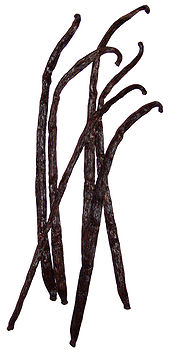
Back Vanielje Afrikaans فانيليا Arabic فانيليا ARZ Vanil Azerbaijani དྲི་ཞིམ་ལྡན་པའི་རྩྭ། Tibetan Vainilla (condiment) Catalan Baynilya CEB ᏩᏁᎳ CHR Vanilka Czech Vanille (Gewürz) German


Vanilla is a spice derived from orchids of the genus Vanilla, primarily obtained from pods of the flat-leaved vanilla (V. planifolia).[1]
Vanilla is not autogamous, so pollination is required to make the plants produce the fruit from which the vanilla spice is obtained.[2] In 1837, Belgian botanist Charles François Antoine Morren discovered this fact and pioneered a method of artificially pollinating the plant. The method proved financially unworkable and was not deployed commercially. In 1841, Edmond Albius, a 12-year-old slave who lived on the French island of Réunion in the Indian Ocean, discovered that the plant could be hand-pollinated.[3] Hand-pollination allowed global cultivation of the plant. Noted French botanist and plant collector Jean Michel Claude Richard falsely claimed to have discovered the technique three or four years earlier. By the end of the 20th century, Albius was considered the true discoverer.[4]
Three major species of vanilla currently are grown globally, all of which derive from a species originally found in Mesoamerica, including parts of modern-day Mexico. They are V. planifolia (syn. V. fragrans), grown on Madagascar, Réunion, and other tropical areas along the Indian Ocean; V. × tahitensis, grown in the South Pacific; and V. pompona, found in the West Indies, Central America, and South America. The majority of the world's vanilla is the V. planifolia species, more commonly known as Bourbon vanilla (after the former name of Réunion, Île Bourbon) or Madagascar vanilla, which is produced in Madagascar and neighboring islands in the southwestern Indian Ocean, and in Indonesia. Madagascar's and Indonesia's cultivations produce two-thirds of the world's supply of vanilla.
Vanilla is the second-most expensive spice (as measured in terms of average price by unit of weight) after saffron because growing the vanilla seed pods is labor-intensive. Nevertheless, vanilla is widely used in both commercial and domestic baking, perfume production, and aromatherapy, as only small amounts are needed to impart its signature flavor and aroma.
- ^ "HS1348/HS1348: Vanilla Cultivation in Southern Florida". edis.ifas.ufl.edu. Archived from the original on 25 December 2022. Retrieved 27 April 2022.
- ^ Maryland Grows (9 November 2020). "Vanilla and food: not plain when it comes to pollination". Maryland Grows. Retrieved 24 June 2022.
- ^ "The Little Boy Who Should've Vanished, but Didn't". Science. 16 June 2015. Archived from the original on 2 March 2021. Retrieved 24 June 2022.
- ^ "Edmond Albius–The boy who revolutionised the vanilla industry". The Linnean Society. Retrieved 9 May 2022.
© MMXXIII Rich X Search. We shall prevail. All rights reserved. Rich X Search